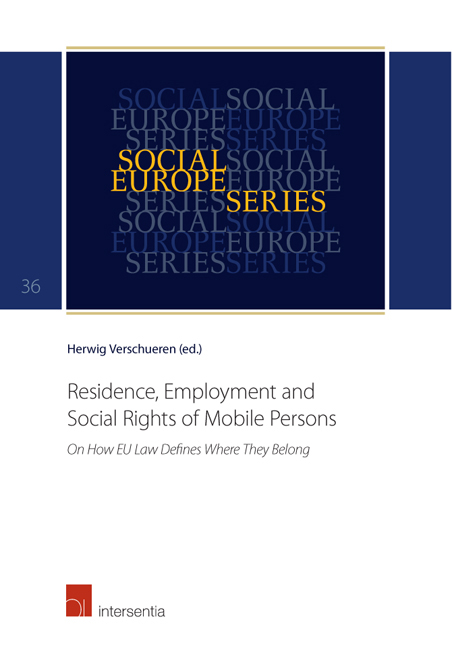Book contents
- Frontmatter
- Preface
- Contents
- List of Abbreviations
- List of Contributors
- Chapter 1 How EU Law Defines where Mobile Persons Belong. An Introduction
- Chapter 2 Family as Link. Explaining the Judicial Change of Direction on Residence Rights of Family Members from Third States
- Chapter 3 The Direction of the Court's Family Reunification Case-Law. A Plea for (Timely) Moderation
- Chapter 4 Sufficient Resources and Residence Rights under Directive 2004/38
- Chapter 5 Free Movement of Persons and European Solidarity. A Melancholic Eulogy
- Chapter 6 Once a Foreigner, Always a Foreigner. Who Does Not Belong Here Anymore? Expulsion Measures
- Chapter 7 Who Does Not Belong Here Anymore? A Statistical Snapshot of Member States’ Practices
- Chapter 8 Civic Integration Exams in EU Immigration Law. What Integration is Not in European Law
- Chapter 9 I Study Here, and Thus I Belong? Mobile Students in the European Union
- Chapter 10 Being Economically Active: How It Still Matters
- Chapter 11 Where Do EU Mobile Workers Belong, According to Rome I and the (E)PWD?
- Chapter 12 Conflicting Rules of Conflict: Social Security and Labour Law
- Chapter 13 Conflicting Rules of Conflict: Social Security and Labour Law. A Response
- Chapter 14 Where Does the UK Belong?
Chapter 4 - Sufficient Resources and Residence Rights under Directive 2004/38
Published online by Cambridge University Press: 22 September 2018
- Frontmatter
- Preface
- Contents
- List of Abbreviations
- List of Contributors
- Chapter 1 How EU Law Defines where Mobile Persons Belong. An Introduction
- Chapter 2 Family as Link. Explaining the Judicial Change of Direction on Residence Rights of Family Members from Third States
- Chapter 3 The Direction of the Court's Family Reunification Case-Law. A Plea for (Timely) Moderation
- Chapter 4 Sufficient Resources and Residence Rights under Directive 2004/38
- Chapter 5 Free Movement of Persons and European Solidarity. A Melancholic Eulogy
- Chapter 6 Once a Foreigner, Always a Foreigner. Who Does Not Belong Here Anymore? Expulsion Measures
- Chapter 7 Who Does Not Belong Here Anymore? A Statistical Snapshot of Member States’ Practices
- Chapter 8 Civic Integration Exams in EU Immigration Law. What Integration is Not in European Law
- Chapter 9 I Study Here, and Thus I Belong? Mobile Students in the European Union
- Chapter 10 Being Economically Active: How It Still Matters
- Chapter 11 Where Do EU Mobile Workers Belong, According to Rome I and the (E)PWD?
- Chapter 12 Conflicting Rules of Conflict: Social Security and Labour Law
- Chapter 13 Conflicting Rules of Conflict: Social Security and Labour Law. A Response
- Chapter 14 Where Does the UK Belong?
Summary
According to Article 7(1)(b) of Directive 2004/38/EC Union citizens, who are not workers or self-employed, only have the right of residence on the territory of another Member State for a period of longer than three months if they have sufficient resources for themselves and their family members not to become a burden on the social assistance system of the host Member State during their period of residence and have comprehensive sickness insurance cover in the host Member State.
This chapter seeks to investigate the meaning of the concept of sufficient resources under Directive 2004/38.1, In section one the question when an inactive citizen has sufficient resources is dealt with by looking at the history of the concept, the national approaches and the Dutch case-law on this issue. The second section gives an overview of the relevant case-law of the CJ, distinguishing two important topics: the level of resources in relation to social assistance benefits and the origin of the resources. This section addresses the most challenging problems of this moment. The third section pays attention to the other condition laid down in Article 7(1)(b) Directive 2004/38, to have comprehensive sickness insurance.
SUFFICIENT RESOURCES
Directive 2004/38/EC makes a distinction between residence up to three months, residence from three months to five years and residence for longer than five years. Different preconditions for residence apply in each of these three categories. Furthermore, the treatment of economically inactive persons differs from the treatment of economically active persons.
The Directive gives in Article 6 all EU citizens a right to entry to any EU Member State without any conditions or formalities, other than the requirement to hold a valid identity card or passport, for three months. It is, however, explicitly stated in Article 24(2) that the host Member State shall not be obliged to confer any entitlement to social assistance during these first three months of residence.
- Type
- Chapter
- Information
- Residence, Employment and Social Rights of Mobile PersonsOn How EU Law Defines Where They Belong, pp. 47 - 74Publisher: IntersentiaPrint publication year: 2016
- 5
- Cited by

